Bmm7203
On this page, you find all documents, package deals, and flashcards offered by seller bmm7203.
- 698
- 0
- 5
Community
- Followers
- Following
22 Reviews received
704 items
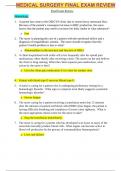
MEDICAL SURGERY FINAL EXAM REVIEW
Final Exam Review Hematology 1. A patient has come to the OB/GYN clinic due to recent heavy menstrual flow. Because of the patient’s consequent increase in RBC production, the nurse knows that the patient may need to increase her daily intake of what substance? a Iron 2. The nurse is planning the care of a patient with the nutritional deficit and a diagnosis of megaloblastic anemia. The nurse should recognize that this patient’s health problem is due to what? a Abnormalities in the ...
- Exam (elaborations)
- • 36 pages •
Final Exam Review Hematology 1. A patient has come to the OB/GYN clinic due to recent heavy menstrual flow. Because of the patient’s consequent increase in RBC production, the nurse knows that the patient may need to increase her daily intake of what substance? a Iron 2. The nurse is planning the care of a patient with the nutritional deficit and a diagnosis of megaloblastic anemia. The nurse should recognize that this patient’s health problem is due to what? a Abnormalities in the ...
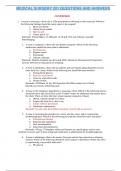
MEDICAL SURGERY 201 QUESTIONS AND ANSWE1RS
CONFIRMED 1. A nurse is assessing a client who is 12hr postoperative following a colon resection. Which of the following findings should the nurse report to the surgeon? 1. Heart rate 90/min 2. Absent bowel sounds 3. Hgb 8.2 g/dl 4. Gastric pH of 3.0 Rationale: Normal Hgb is 13-18M g/dl, 12-16 g/dl. This may indicate a possible hemorrhaging. 2. A nurse is caring for a client who has diabetes insipidus. Which of the following medications should the nurse plan to administer? a. Desmopre...
- Exam (elaborations)
- • 22 pages •
CONFIRMED 1. A nurse is assessing a client who is 12hr postoperative following a colon resection. Which of the following findings should the nurse report to the surgeon? 1. Heart rate 90/min 2. Absent bowel sounds 3. Hgb 8.2 g/dl 4. Gastric pH of 3.0 Rationale: Normal Hgb is 13-18M g/dl, 12-16 g/dl. This may indicate a possible hemorrhaging. 2. A nurse is caring for a client who has diabetes insipidus. Which of the following medications should the nurse plan to administer? a. Desmopre...
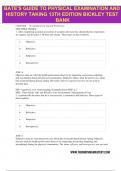
Foundations for Clinical Proficiency
CHAPTER 1 Foundations for Clinical Proficiency MULTIPLE CHOICE 1. After completing an initial assessment of a patient, the nurse has charted that his respirations are eupneic and his pulse is 58 beats per minute. These types of data would be: a . Objective. b . Reflective. c . Subjective. d . Introspective. ANS: A Objective data are what the health professional observes by inspecting, percussing, palpating, and auscultating during the physical examination. Subjective data is what ...
- Exam (elaborations)
- • 225 pages •
CHAPTER 1 Foundations for Clinical Proficiency MULTIPLE CHOICE 1. After completing an initial assessment of a patient, the nurse has charted that his respirations are eupneic and his pulse is 58 beats per minute. These types of data would be: a . Objective. b . Reflective. c . Subjective. d . Introspective. ANS: A Objective data are what the health professional observes by inspecting, percussing, palpating, and auscultating during the physical examination. Subjective data is what ...

NURSING 507 FINAL EXAM STUDY GUIDE REPRODUCTION
FINAL EXAM STUDY GUIDE Reproductive Endometrial cycle and the occurrence of ovulation -menstrual cyclestarts with menarche (first menstruation) ends with menopause (cessation of menstrual flow for 1 year) -Cycles -anovulatory at first may vary in length from 10 to 60 days or more. -As adolescence proceeds into adulthood, regular patterns of menstruation and ovulation are established at intervals ranging from 21 to 45 days. -Menstruation continues to recur in a recognizable and cha...
- Exam (elaborations)
- • 89 pages •
FINAL EXAM STUDY GUIDE Reproductive Endometrial cycle and the occurrence of ovulation -menstrual cyclestarts with menarche (first menstruation) ends with menopause (cessation of menstrual flow for 1 year) -Cycles -anovulatory at first may vary in length from 10 to 60 days or more. -As adolescence proceeds into adulthood, regular patterns of menstruation and ovulation are established at intervals ranging from 21 to 45 days. -Menstruation continues to recur in a recognizable and cha...

CARDIAC AND RESPIRATORY STUDY GUIDE FOR NRSG 2730
Cardiac Study Guide for NRSG 2730 (20 questions ) 1. Know your rhythms 2. Be able to distinguish between the different types of cardiomyopathies 3. Care of a pacemaker 4. Care of the CHF patient Respiratory Study Guide for NRSG 2730 (13 questions) 1. ABG- non-compensation/ compensation a. pH:7.35-7.45 b. PCO2:35-45 (reverse) c. HCO3:22-26 - Full compensation o Achieved if the pH is within normal range - Partial compensation o Achieved if the respiratory and metabolic process are op...
- Exam (elaborations)
- • 18 pages •
Cardiac Study Guide for NRSG 2730 (20 questions ) 1. Know your rhythms 2. Be able to distinguish between the different types of cardiomyopathies 3. Care of a pacemaker 4. Care of the CHF patient Respiratory Study Guide for NRSG 2730 (13 questions) 1. ABG- non-compensation/ compensation a. pH:7.35-7.45 b. PCO2:35-45 (reverse) c. HCO3:22-26 - Full compensation o Achieved if the pH is within normal range - Partial compensation o Achieved if the respiratory and metabolic process are op...
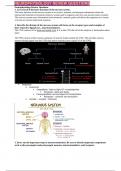
NEUROPHYSIOLOGY REVIEW QUESTIONS
Neurophysiology Review Questions 1. List several of the basic functions of the nervous system. The basic function of the nervous system is to receive, transmit, and interpret information about the internal and external environment (sensory system) and to organize and carry out actions (motor system). The nervous system uses information from memories, intrinsic goals and drives the organism on a course of action to execute behavioral response. 2. Describe the division of the nervous system ...
- Exam (elaborations)
- • 27 pages •
Neurophysiology Review Questions 1. List several of the basic functions of the nervous system. The basic function of the nervous system is to receive, transmit, and interpret information about the internal and external environment (sensory system) and to organize and carry out actions (motor system). The nervous system uses information from memories, intrinsic goals and drives the organism on a course of action to execute behavioral response. 2. Describe the division of the nervous system ...
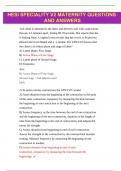
HESI SPECIALITY V2 MATERNITY QUESTIONS AND ANSWERS
1) A client is admitted to the labor and delivery unit with contractions that are 3-5 minutes apart, lasting 60-70 seconds. She reports that she is leaking fluid. A vaginal exam reveals that her cervix is 80 percent effaced and 4 cm dilated and a -1 station. The LPN/LVN knows that the client is in which phase and stage of labor? A) Latent phase, First Stage B)Active Phase of First Stage C) Latent phase of Second Stage D) Transition Ans: B) Active Phase of First Stage Second stage = fu...
- Exam (elaborations)
- • 12 pages •
1) A client is admitted to the labor and delivery unit with contractions that are 3-5 minutes apart, lasting 60-70 seconds. She reports that she is leaking fluid. A vaginal exam reveals that her cervix is 80 percent effaced and 4 cm dilated and a -1 station. The LPN/LVN knows that the client is in which phase and stage of labor? A) Latent phase, First Stage B)Active Phase of First Stage C) Latent phase of Second Stage D) Transition Ans: B) Active Phase of First Stage Second stage = fu...
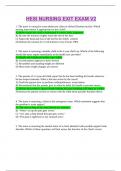
HESI NURSING EXIT EXAM V2
1. The nurse is caring for a pre-adolescent client in skeletal Dunlop traction. Which nursing intervention is appropriate for this child? A) Make certain the child is maintained in correct body alignment. B) Be sure the traction weights touch the end of the bed. C) Adjust the head and foot of the bed for the child's comfort D) Release the traction for 15-20 minutes every 6 hours PRN. 2. The nurse is assessing a healthy child at the 2 year check up. Which of the following should the nurse...
- Exam (elaborations)
- • 37 pages •
1. The nurse is caring for a pre-adolescent client in skeletal Dunlop traction. Which nursing intervention is appropriate for this child? A) Make certain the child is maintained in correct body alignment. B) Be sure the traction weights touch the end of the bed. C) Adjust the head and foot of the bed for the child's comfort D) Release the traction for 15-20 minutes every 6 hours PRN. 2. The nurse is assessing a healthy child at the 2 year check up. Which of the following should the nurse...

HESI BIO QUESTIONS AND ANSWERS
1. Which of the following is not true of mitosis? A. Mitosis produces daughter cells B. Mitosis has five main stages C. Mitosis can only be done by haploids D. Following mitosis, daughter cells are identical to parent cells 2. In meiosis, the chromosome number is reduced from: A. 46 to 23 B. 46 to 33 C. 28 to 14 D. 24 to 12 3. Cellular respiration takes place in which of the following? A. Golgi apparatus B. Mitochondrion C. Chloroplast D. Ribosome 4. Which of the following is the ...
- Exam (elaborations)
- • 25 pages •
1. Which of the following is not true of mitosis? A. Mitosis produces daughter cells B. Mitosis has five main stages C. Mitosis can only be done by haploids D. Following mitosis, daughter cells are identical to parent cells 2. In meiosis, the chromosome number is reduced from: A. 46 to 23 B. 46 to 33 C. 28 to 14 D. 24 to 12 3. Cellular respiration takes place in which of the following? A. Golgi apparatus B. Mitochondrion C. Chloroplast D. Ribosome 4. Which of the following is the ...
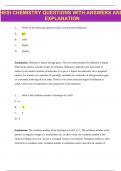
HESI CHEMISTRY QUESTIONS WITH ANSWERS AND EXPLANATION
1. Which of the following substances allows for the fastest diffusion? A. gas B. solid C. liquid D. plasma Explanation: Diffusion is fastest through gases. The next fastest medium for diffusion is liquid, followed by plasma, and then solids. In chemistry, diffusion is defined as the movement of matter by the random motions of molecules. In a gas or a liquid, the molecules are in perpetual motion. For instance, in a quantity of seemingly immobile air, molecules of nitrogen and oxygen are...
- Exam (elaborations)
- • 14 pages •
1. Which of the following substances allows for the fastest diffusion? A. gas B. solid C. liquid D. plasma Explanation: Diffusion is fastest through gases. The next fastest medium for diffusion is liquid, followed by plasma, and then solids. In chemistry, diffusion is defined as the movement of matter by the random motions of molecules. In a gas or a liquid, the molecules are in perpetual motion. For instance, in a quantity of seemingly immobile air, molecules of nitrogen and oxygen are...

ESSENTIALS OF UNDERSTANDING PSYCHOLOGY 10TH EDITION BY ROBERT FELDMAN TEST BANK
Burns-Pediatric-Primary-Care-7th-Edition-Test-Bank11-yflayj.docx
Test Bank Varcarolis' Foundations of Psychiatric-MentalHealth Nursing A Clinical 9th Edition by Margaret JordanHalter |Test Bank|Chapter 1-36 UPDATED 2022
Test Bank Varcarolis' Foundations of Psychiatric-MentalHealth Nursing A Clinical 9th Edition by Margaret JordanHalter |Test Bank|Chapter 1-36 UPDATED 2022
BETH MORLING RESEARCH METHODS IN PSYCHOLOGY THIRD EDITION
GREAT JOB